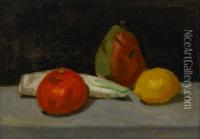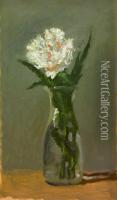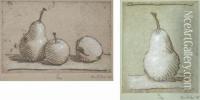Robert M. Kulicke Paintings
Robert M. Kulicke, born in Philadelphia in 1924, was an American artist best known for his contributions to still life painting and frame design. He is recognized for his delicate and innovative approach to still lifes, often featuring flowers or fruits captured in a simple, yet profoundly elegant manner. Kulicke's style was marked by a blend of modernism and tradition, capturing the essence of his subjects with a fresh perspective while maintaining a timeless quality.
Kulicke studied at the Tyler School of Art in Philadelphia and later at the Columbia University in New York City. He also spent time studying in Paris, where he was influenced by the works of European masters. Throughout his career, Kulicke was not only a painter but also a teacher, frame maker, and jewelry designer. His diverse skills and interests contributed to a multifaceted approach to his art.
Kulicke's most significant contribution to the art world may well be his innovative frame designs. He founded Kulicke Frames, a company that produced a line of simple, yet elegant frames that became the standard for framing modern art. His frames were admired for their minimalistic design and were used by a number of prominent galleries and museums to display contemporary works.
As an educator, Kulicke taught at the Parsons School of Design and the School of Visual Arts in New York City, influencing a generation of young artists. His teaching philosophy emphasized the importance of mastering traditional techniques as a foundation for innovation.
Robert M. Kulicke's work has been exhibited in numerous galleries and museums, including the Museum of Modern Art in New York and the Philadelphia Museum of Art. His legacy continues to be celebrated for its subtle beauty and his contributions to the fields of painting and frame-making.
Kulicke passed away in 2007, leaving behind a body of work that continues to influence still life painters and frame designers. His artistic vision and commitment to craft have secured him a lasting place in the history of American art.


